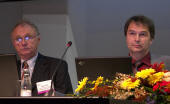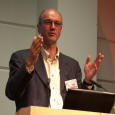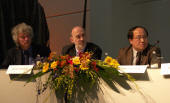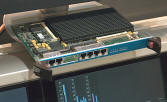
"Inside the Convention.."
Mel Lambert's reports for "The AES Daily"
Multichannel Symposium – “Surround Sound in Broadcasting” |
 Sunday May 9, 2004: As in previous years, Friday’s pre-convention Symposium gathered together a number of industry luminaries to focus on a contemporary hot topic; this year it was the turn of multichannel radio broadcasting. Co-chaired by Jürgen Marchlewitz, of Westdeutscher Rundfunk, and Martin Wöhr, Bayerischer Rundfunk (pictured right), the one-day Symposium provided a unique opportunity to review the current state-of-the-art in multichannel delivery via satellite, broadband internet and other media, as well as examine archiving and infrastructure requirements.
Sunday May 9, 2004: As in previous years, Friday’s pre-convention Symposium gathered together a number of industry luminaries to focus on a contemporary hot topic; this year it was the turn of multichannel radio broadcasting. Co-chaired by Jürgen Marchlewitz, of Westdeutscher Rundfunk, and Martin Wöhr, Bayerischer Rundfunk (pictured right), the one-day Symposium provided a unique opportunity to review the current state-of-the-art in multichannel delivery via satellite, broadband internet and other media, as well as examine archiving and infrastructure requirements.
Addressing real-word surround-sound production and delivery, Bosse Ternström from Swedish Radio, and Kimio Hamasaki from NHK, Tokyo, emphasized that existing infrastructures can handle data-reduced multichannel audio running at up to 1.5 Mbits/seconds; Swedish Radio has broadcast a number of programs with DST-encoded surround, while NHK favors 384 Kbit MPEG-2 AAC. “5.1-channel surround sound is the future of digital radio,” Hamasaki stressed.
During a session on Archiving Multichannel Productions, Udo Appel of Bayerischer Rundfunk detailed the design criterion for a tape robotic system to store essence data with companion metadata, while Yvonne Graf of IBM-Germany described the ADMIRA system for managing data files and add-on agents for generating application-specific metadata. “Multichannel productions are just another format for your digital archive,” she considered. (The soon-to-be-released IBM Ice Cube will store 26 TBytes of data in a 60x60x60-cm package.)
Broadcast Distribution was covered by Heinz-Peter Reykers, Westdeutscher Rundfunk, who described a flexible system for carrying two stereo channels and an AC3-endcoded surround channel over a 2-Mbit E1 lines, while Gerhard Möller of DAVID-Germany focused on his firm’s new workflow for packaging data from acquisition through integration to delivery, including use of Extended BWAV files.  Dr. Francis Ramsey from the University of Surrey (pictured left) described a fascinating research study into the affect of reducing bandwidth and data channels on perceived sound quality – dependent upon the program material, it would seem that we can trade off both parameters to reduce overall data rate, with minimal sonic impact – while Günther Theile of IRT described a variety of downmix schemes. And Gerhard Stoll from IRT provided an animated overview of the Institute’s MCAT (Multi-Channel Audio Transmission) Working Group.
Dr. Francis Ramsey from the University of Surrey (pictured left) described a fascinating research study into the affect of reducing bandwidth and data channels on perceived sound quality – dependent upon the program material, it would seem that we can trade off both parameters to reduce overall data rate, with minimal sonic impact – while Günther Theile of IRT described a variety of downmix schemes. And Gerhard Stoll from IRT provided an animated overview of the Institute’s MCAT (Multi-Channel Audio Transmission) Working Group.
Asked the highly relevant question: “What is the future of multichannel radio?” responses from symposium participants and industry insiders ranged from optimistic to pessimistic. “People want 5.1-channel,” Swedish Radio’s Ternström enthused,  while Ernst Dohlus from Bayerischer Rundfunk questioned the added cost. “Who are our customers,” he queried? “Most of them use radio as background or while in their cars, or in rooms that are too small for surround sound.” In contrast, IBM’s Graf stated that Dolby Digital is already being used by consumers for DVD-Video playback; many radio listeners already own 5.1-channel home theater systems.
while Ernst Dohlus from Bayerischer Rundfunk questioned the added cost. “Who are our customers,” he queried? “Most of them use radio as background or while in their cars, or in rooms that are too small for surround sound.” In contrast, IBM’s Graf stated that Dolby Digital is already being used by consumers for DVD-Video playback; many radio listeners already own 5.1-channel home theater systems.
“Radio is a high quality provider,” NHK’s Hamasaki stated (pictured extreme right in adjacent image), “and can give an impetus to the audio community,” while DAVID’s Möller (pictured center in adjacent image) offered that “radio can add spatial awareness, even in automobiles.” IRT’s Theile ((pictured extreme left in adjacent image) concluded that “multichannel radio is a high-quality deliver medium, capable of motivating listeners.”
As was to be expected, the symposium provided a unique opportunity for in-depth discussions on up-to-the-minute issues.
Fourth-Generation DAWs – Ready for Primetime? |
Monday May10, 2004: While wandering these hallowed exhibition halls, I was struck by a dramatic example of technological convergence. That two leading pro-audio manufacturers had reached the same conclusion was remarkable; that their response appears so different is highly significant. I’m referring, of course, to integrating multichannel mixing, editing and signal processing within a single system, to take full advantage of the DSP power of today’s fourth-generation DAWs. The new Digidesign ICON Integrated Console (pictured lower left) and Solid State Logic AWS 900 Analogue Workstation System (pictured lower right) both offer one-stop mixing, editing and signal processing, but with dramatically contrasting topologies.
Digidesign (stand 3208) decided to develop an advanced work surface and proprietary protocol that enables every Pro Tools control setting, including plug-ins, to be modified from assignable front-panel faders, knobs and ![]() switches. Now, as David Gibbons, Digidesign’s Director of Product Management, explained, “ICON breaks down the workflow barriers in which people have been trapped. Mixing a music and sound editorial project is a continual process; our customers need the ability to start a project on one Pro Tools system, and continue on another, but without losing the ability to recall the entire project and all of its control settings. ICON opens up a large number of options for users.”
switches. Now, as David Gibbons, Digidesign’s Director of Product Management, explained, “ICON breaks down the workflow barriers in which people have been trapped. Mixing a music and sound editorial project is a continual process; our customers need the ability to start a project on one Pro Tools system, and continue on another, but without losing the ability to recall the entire project and all of its control settings. ICON opens up a large number of options for users.”
“A Pro Tools user can start a session on a 002 or MBox and laptop PC,” continued Rich Nevens, Digidesign’s International Sales Manager /Consoles, “and finish in a commercial studios without loosing any of the project’s evolving mix, EQ, dynamics and plug-in settings. Everything stays with the sound files; you just have more access to the [control] settings on the ICON’s [D-Control Tactile Worksurface] than a PC/Mac GUI. Using a separate add-on analog or digital mixer is archaic; you shouldn’t have to use two automation systems. The ICON control surface is an extension of Pro Tools.”
Niall Feldman,  the firm’s Director of Product Marketing, stressed that SSL (stand 2202) developed its hybrid AWS 900 from a different perspective. “AWS 900 is a combination of a compact analogue mixing console and a comprehensive DAW controller,” he explained.” We were the first company to integrate automation and machine control into the mixing console, and SSL pioneered surround mixing. The new AWS 900 delivers the same powerful integration benefits to DAW users, who face similar challenges.” By incorporating Mackie’s HUI MIDI-based command protocol, users of Pro Tools, Nuendo, Logic and similar DAWs can benefit from a fully-analogue front-end for tracking and overdubs, mated to with a sophisticated 5.1-channel monitor section. During mixing, of course, all of the AWS 900’s assignable faders and knobs control mix levels within the companion workstation.
the firm’s Director of Product Marketing, stressed that SSL (stand 2202) developed its hybrid AWS 900 from a different perspective. “AWS 900 is a combination of a compact analogue mixing console and a comprehensive DAW controller,” he explained.” We were the first company to integrate automation and machine control into the mixing console, and SSL pioneered surround mixing. The new AWS 900 delivers the same powerful integration benefits to DAW users, who face similar challenges.” By incorporating Mackie’s HUI MIDI-based command protocol, users of Pro Tools, Nuendo, Logic and similar DAWs can benefit from a fully-analogue front-end for tracking and overdubs, mated to with a sophisticated 5.1-channel monitor section. During mixing, of course, all of the AWS 900’s assignable faders and knobs control mix levels within the companion workstation.
 Bang in the middle of this all-digital-thru-analog–hybrid continuum lies Euphonix (stand 3737), which is demonstrating EuCon-based control from a System 5 worksurface of not only its own DSP Core and a Steinberg Nuendo digital audio workstation, but also the new Sony Oxford Mix Engine (pictured left), which offers one-bit/128Fs DSD or 192 kHz PCM mixing, EQ and dynamics. Now it’s possible to mix both DSD and PCM projects using dedicated hardware and DAW engines hooked to a familiar control surface.
Bang in the middle of this all-digital-thru-analog–hybrid continuum lies Euphonix (stand 3737), which is demonstrating EuCon-based control from a System 5 worksurface of not only its own DSP Core and a Steinberg Nuendo digital audio workstation, but also the new Sony Oxford Mix Engine (pictured left), which offers one-bit/128Fs DSD or 192 kHz PCM mixing, EQ and dynamics. Now it’s possible to mix both DSD and PCM projects using dedicated hardware and DAW engines hooked to a familiar control surface.
It’s all about appropriate hardware and connectivity; after all, creativity doesn’t exist in a vacuum these days.
>>SSL AWS 900 Hybrid System >>Digidesign ICON Integrated Console >> EuCon Protocol overview
The contents of this news feature is exclusive to and the sole property of Media&Marketing ©2023.
All rights reserved. This material cannot be reproduced in whole or in part without written permission of Media&Marketing. Primary images ©2025 content-creators.com.
![]()
©2025 Media&Marketing. All Rights Reserved. Last revised: 01.04.25